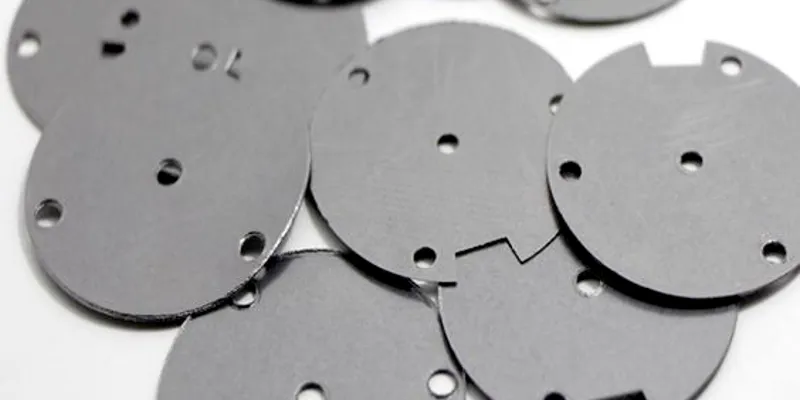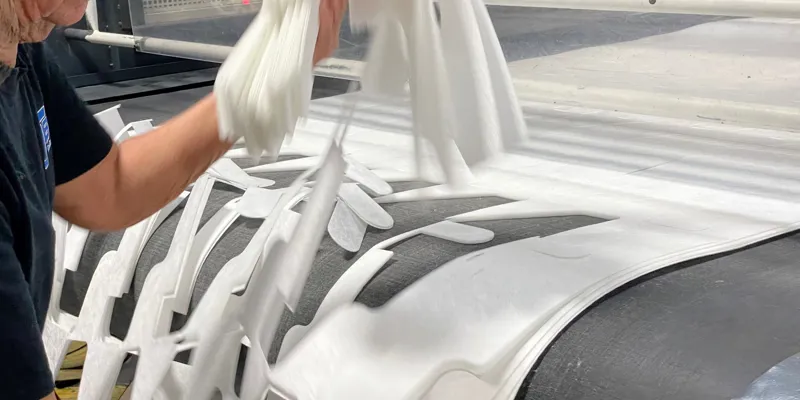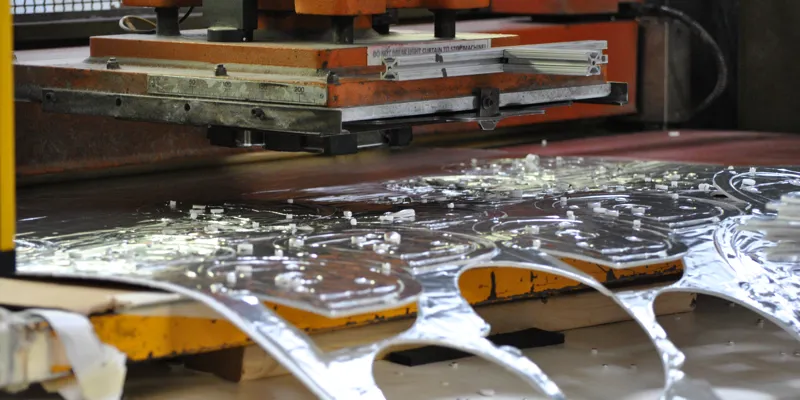
Material Converting Flatbed Die-Cutting at JBC Technologies
If you'd like to learn more about flatbed die-cutting and our flatbed die-cutting capabilities in particular, you're in the right place.
Here we'll highlight our flatbed die-cutting capabilities, share a bit more about flatbed die-cutting in general, and explain why we might suggest this manufacturing method as the best process for your custom die-cut parts project.
If you're interested in a general overview of our precision die-cutting capabilities you can view that here.

What is Flatbed Die-Cutting?
Steel rule, platen-press, or, as it's most commonly known, flatbed die-cutting, is a popular form of precision material converting.
Flatbed die-cutting is one of the most adaptable die-cutting methods, making it an excellent choice for making parts used for gasketing, sealing, insulation, labeling, and heat shielding applications.
Our flatbed die-cutting machines use a hydraulic or electric press to push a cutting die down into the material and against a solid, flat surface or bed. This process creates a single shape or multiple nested shapes before the die is raised back up into its starting position, ready to do it all over again.
Flatbed Die-Cutting Features & Benefits
Compared to rotary die-cutting, flatbed die-cutting isn't known for its speed. What flatbed die-cutting lacks in swiftness, it more than makes up for in adaptability and flexibility.
The primary benefits of flatbed die-cutting include:
► Lower tooling costs
► Multi-part nesting
► Larger part sizes
► Cut Materials up to 4" thick
► Easier sLUG REMOVAL
► Handles Material In Sheets
► Supports PERFORATING
Flatbed Die-Cutting – Material & Cutting Die Considerations

One of the most significant benefits of using a flatbed die-cutting press is its ability to handle just about any relatively thin, flexible material that comes in rolls or sheets and is between 1/8" and 4" thick.
Cutting die considerations:
- Thicker, rigid materials like some plastic sheeting and metal foils may require a more robust cutting die with longer, more angled cutting bevels
- Thinner, softer materials can be cut more efficiently and usually require simpler, less costly cutting dies
Flatbed die-cutting presses are generally capable of exerting more force per unit area than rotary die-cutting presses, making them more well-suited for cutting thicker, denser, and more rigid materials.
Some common materials that can be die-cut on a flatbed press include:
- Light gauge metal foils
- Foams & Sponge Rubbers
- Solid/Dense Rubbers
- Ceramic Papers & Blankets
- Plastic films
- Fabrics
- Papers
- Multi-Layer Composites like JBC's TABshield
Primary Advantages of Flatbed Die-Cutting
Flatbed die-cutting makes parts by cutting perpendicular to the surface of the material, making for more consistent results with minimal material deformation and smoother, less rounded (apple-coring) cut edges.
The most basic flatbed die-cutting process requires only three parts – the material, the steel rule cutting die, and the cutting surface. After assembly, a flatbed press can cut simple part features with a single stroke.
Production tooling for flatbed die-cutting presses typically costs significantly less (often 50% or less) than tooling for a rotary die-cutting press. This up-front cost structure is ideal for producing many similar, relatively simple parts at an economical rate, which is advantageous for short or medium production runs.
Most industrial flatbed die-cutting presses perform well if the material is between 1/8" and 4" thick, flexible, and comes in rolls or sheets. When it comes to part size, the only limitation is the width of the material, and the size of the cutting die itself.
Flatbed die-cutting isn't known for its speed, but what it lacks in swiftness, it more than makes up for in adaptability and flexibility. Most custom steel-rule dies can also be designed to cut multiple parts simultaneously (nesting), making it straightforward to adjust the production volumes of larger, cumbersome parts.
Flatbed Die-Cutting Capabilities
Flatbed die-cutting is ideal for fabricating parts made of foams and elastomers, ceramic papers and blankets, light-gauge aluminum foils, plastics, felts, and more. Typical capabilities of flatbed die-cutting can include

Through-cutting
Through-cutting (aka metal-to-metal cutting) is a type of die-cutting in which the cutting die makes the parts by cutting through the materials and any liner backings and into the underlying flatbed.
After the through-cutting process, the die-cut parts are entirely separated from the web (matrix) of material and packaged.

Perforating
Perforating is the best option if you want the die-cut parts to remain within the material web for later removal.
A perforated part is held within the stock material by a series of small material connections or holes called perforations, preventing it from fully separating from the base material but allowing it to be easily detachable along the perforations.

Kiss-cutting
During the kiss-cutting process, the steel rule blades penetrate the material surface and pressure-sensitive adhesive without cutting through the adhesive backing.
Kiss-cutting leaves the parts on the liner backing, so they can be removed quickly and easily for assembly and final application. Kiss-cutting is a converting process customarily used for adhesive-backed parts.

Scoring
Scoring, as opposed to through-cutting, is a converting process during which the cutting die makes an indent, impression, or partial cut into the material rather than cutting through it.
The purpose of a score is to reduce the material thickness at a single stress point for easier bending and folding during the final assembly.
Flatbed Die-Cutting Pros & Cons
While flatbed die-cutting is known as a flexible and robust production method, it's not a one-size-fits-all manufacturing process. Here are just a few of the pros and cons of flatbed die-cutting vs other die-cutting methods:

Flatbed Die-Cutting Efficiency CON
Compared to a rotary die-cutting press, most larger flatbed presses are downright slow.
It is possible to improve this efficiency with part nesting (multiple parts designs together in the same die) and with automatic material feeders.

Flatbed Die-Cutting Materials PRO
Flatbed die-cutting machines can cut parts out of nearly every common type of thin, flexible material.
Flatbed cutting presses can also make use of material up to 4” thick and supplied in large rolls/coils or sheets.

Flatbed Die-Cutting Part Tolerances CON
Because of steel rule die limitations, flatbed die-cutting isn't typically the best choice for making intricately-designed parts with tight dimensional tolerances.
Flatbed die-cutting can be an exceptional choice for parts with relatively simple designs and lower dimensional tolerances.

Flatbed Die-Cutting Production Costs PRO
Normally, the up-front production costs associated with flatbed die-cutting are much lower than, say, rotary die-cutting, due mainly to the lower cost of the steel rule cutting die.
It’s possible to lower these costs further by incorporating multiple parts into the same die using part nesting.
Contact JBC Technologies Today for Flatbed Die-Cutting Services
JBC Technologies is a leading materials converter and custom solutions manufacturer. We have over 30 years of experience with performance materials selection and custom die-cutting, and our precision flatbed die-cutting expertise is unparalleled. JBC has dozens of flatbed die-cutting presses, each with unique performance parameters and advantages. You tell us what parts you need and what they need to do, and we'll work with you to determine the best manufacturing methods for the job.





